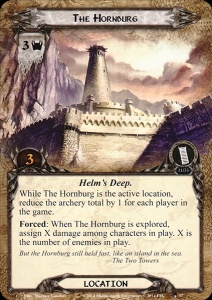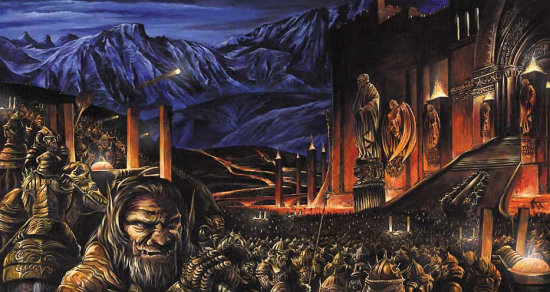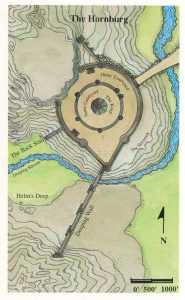 The first great battle of the War of the Ring happens on home turf for the Rohirrim. Saruman empties Isengard of its vast armies, tens of thousands of orcs and half-orcs and warg riders and Dunlendings, in a great push to end the inconvenience that is the Horse Lords and claim their lands. When King Théoden and his host wish to bring battle to Isengard and call Saruman the traitor to account, they are pushed back and forced to take refuge in the Hornburg at Helm’s Deep. There they are set upon by a veritable ocean of enemies that come to strike down the last defense of Rohan. But it is said that Helm’s Deep could not fall, not if it was manned. Evidently we players aren’t ‘manned’ enough because the Helm’s Deep quest of The Treason of Isengard box has let me fall many a time. As interesting and exciting as the ‘Defense’ mechanic is, I have not talked with one player who hasn’t been frustrated by it. But today we’ll learn a bit about the place and, in particular, the fortress of The Hornburg.
The first great battle of the War of the Ring happens on home turf for the Rohirrim. Saruman empties Isengard of its vast armies, tens of thousands of orcs and half-orcs and warg riders and Dunlendings, in a great push to end the inconvenience that is the Horse Lords and claim their lands. When King Théoden and his host wish to bring battle to Isengard and call Saruman the traitor to account, they are pushed back and forced to take refuge in the Hornburg at Helm’s Deep. There they are set upon by a veritable ocean of enemies that come to strike down the last defense of Rohan. But it is said that Helm’s Deep could not fall, not if it was manned. Evidently we players aren’t ‘manned’ enough because the Helm’s Deep quest of The Treason of Isengard box has let me fall many a time. As interesting and exciting as the ‘Defense’ mechanic is, I have not talked with one player who hasn’t been frustrated by it. But today we’ll learn a bit about the place and, in particular, the fortress of The Hornburg.
At Helm’s Gate, before the mouth of the Deep, there was a heel of rock thrust outward by the northern cliff. There upon its spur stood high walls of ancient stone, and within them was a lofty tower. Men said that in the far-off days of the glory of Gondor the sea-kings had built here this fastness with the hands of giants. The Hornburg it was called, for a trumpet sounded upon the tower echoed in the Deep behind, as if armies long-forgotten were issuing to war from caves beneath the hills. — The Two Towers
When the Men of Númenor came out of the Sea, after the destruction of their home, and landed in Middle-earth they swiftly founded the mighty
realms of Gondor and Arnor from the ‘colonies’ they had created in their seafaring days. To subdue their enemies and keep the peace, they built fortresses and outposts and these are seen throughout the journeys of the Fellowship in The Lord of the Rings: Isengard, the Towers of the Teeth, the Tower of Cirith Ungol, Minas Morgul, and of course Minas Tirith. Each time we reach one of these great buildings the narrator remarks about how they were built before the skill of the Men of Westernesse waned. What that means is not entirely specified, but it is tied to the mingling of the Dúnedain with lesser Men, and their lack of vigilance in keeping to the study of lore in the latter days of the Third Age. Faramir says that the men of Gondor have become more like their distant cousins in Rohan and the North, reveling more in battle than learning. That learning, from deep ages in the past when Men had better relations with Elves and gods, taught them to make great constructions of smooth, solid stone that seemed to be made from the very bones of the earth itself. Helm’s Deep was one such construction.
Rohan was once the Gondorian province of Calenardhon. In a great time of need, the Éothéod came out of the North and rescued the Gondorians from an attack of evil Men and Orcs. As a gift, the ruling Steward Cirion gave the land as a gift to Eorl the Young and his people for as long as they would help to defend Gondor. With it came the fortress of Helm’s Deep.
At the time when we see it, TA 3019, Helm’s Deep is the seat of The Lord of Westfold. At this time, that lordship is held by Erkenbrand, a mighty man
who later earns the title of Marshal of the West-mark. But Erkenbrand is not there when Théoden and his companions arrive at the Hornburg; he is off defending the Ford’s of Isen. And so the King and his companions, including Aragorn son of Arathorn and Legolas the Elf and Gimli the Dwarf, are left to defend themselves without aid and with only a small compliment of soldiery. When the full host of Saruman is unleashed, Erkenbrand must retreat and that is when he meets Gandalf the White and with the coming of the morning the two, along with 1000 footmen of Rohan, arrive at the battle of Helm’s Deep to win the day.
Getting back to the fortress itself, The Hornburg, and the caves behind it, were part of the great fortification that would so defend the Men of Rohan (along with their Elf and Dwarf guests). Most of this was man made, of course, but it’s the location that is key. Helm’s Deep is, as the name suggests, nestled deep in the shadow of the Ered Nimrais, the White Mountains. It’s the natural setting that provides its greatest defense, for there is only one direction enemies can attack from and that is northeastwards through the Deeping Coomb.
Within the Hornburg itself is a number of levels. King Théoden remained in the Great Hall during the attack until his glorious ride out in the morning, but there were more levels to be used in case of a final breech.The Hornburg is the actual fortress-y bit of Helm’s Deep and it’s here that the architectural prowess of Gondor is best demonstrated. It is joined by the Deeping Wall that spans that gap in the mountainsides between the Burg and the further hill, preventing entry into the Caves beyond. There many men and stores could remain safe under a determined attack. The stone walls of both Burg and Wall are sheer and nigh unscalable. During the Battle, the armies of the White Hand have to use siege ladders and towers to make any attempt to climb over while they beat the door of the Hornburg. It all holds. Even the blasting powder of Saruman, enough to tear a hole in the Wall through the culvert where the stream passes, does not gain them entry into the Burg.
In the end, as we know, the Rohirrim win. It takes a little help from Gandalf and the Huorns, but what was meant as the final stroke by Saruman is turned against him and, coupled with the march of the Ents on Isengard, his power is swiftly broken. After the War, Helm’s Deep remains under the possession of the Rohirrim, their bond to Gondor now doubly renewed with the coming of the King and the marriage of Faramir, Prince of Ithilien, to Éowyn. But an unusual thing happens: Gimli the dwarf, so moved by his unexpected visit to the caves beyond Helm’s Deep, returns with a company of his folk. There he sets up a colony of dwarves in Aglarond, the Glittering Caves, and becomes a lord of his people. They remain their long, help to rebuild the Wall and the Hornburg, and presumably share the fortress with their counterparts in Rohan.
Mechanically, the card works very well in representing the fortress’ security: the flying arrows of the enemy can hardly reach our heroes while they are safely inside. But once the enemy armies penetrate its walls those heroes are going to start taking hits!
Looking into The Hornburg reminds me that there is, as it is with pretty much all of Tolkien’s lore, a great expanse of story to cover: Helm himself (see Michael’s article on The Dunland Trap for more on him); the Glittering Caves; Cirion and Eorl; the rest of Helm’s Deep. Look for more articles on that soon! In the mean time, hold fast until The Wastes of Eriador arrives!

Helm’s Deep by caitmf1


